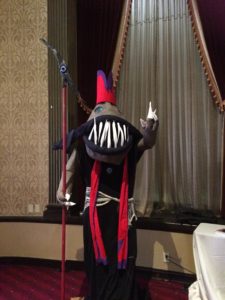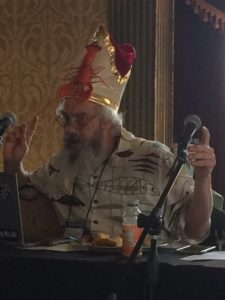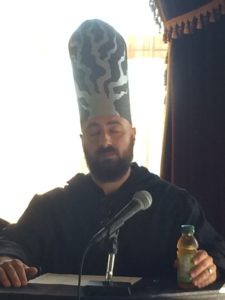Welcome to 2018, friends! This year, I have resolved to be more trans, put a higher priority on my own writing, and go deeper into my eclectic spiritual journey. I’m asking myself why I don’t spend more time on the things that I think matter most to me. Am I deceiving myself about what I really want, or am I uncertain of my right or ability to follow my dreams?
I find that there’s always further to go in healing. More unconscious self-defeating messages to unearth and expose as false. More outworn shapes of life and relationships, now-rusting cage bars to notice and shove aside. More old fears that it’s selfish for me to attempt a more sustainable balance between self-care and availability to others.
A close friend of mine rightly says that “all abuse is a 10 out of 10 to the person who suffers it.” It’s not loving to minimize your experience with comparisons to someone else’s story. However, in the world of social services and self-help literature, non-physical violation is often shortchanged. There are precious few support groups for childhood trauma survivors as it is, and all the ones I’ve found locally are limited to women who were sexually abused.
Andrew Vachss is a successful thriller writer and child protection attorney. His books often deal with themes of child abuse and neglect. Vachss’ Twitter feed is a steady source of affirming messages for survivors of family estrangement and trauma. Originally published in Parade Magazine in 1994 and reprinted on his website, his article “You Carry the Cure in Your Own Heart” validates the struggles of emotional abuse survivors and offers good advice for healing. The guilt feelings he describes are the reason I sometimes get hooked into over-extending myself. Some excerpts:
…[O]f all the many forms of child abuse, emotional abuse may be the cruelest and longest–lasting of all.
Emotional abuse is the systematic diminishment of another. It may be intentional or subconscious (or both), but it is always a course of conduct, not a single event. It is designed to reduce a child’s self–concept to the point where the victim considers himself unworthy—unworthy of respect, unworthy of friendship, unworthy of the natural birthright of all children: love and protection…
*
…When it comes to damage, there is no real difference between physical, sexual and emotional abuse. All that distinguishes one from the other is the abuser’s choice of weapons. I remember a woman, a grandmother whose abusers had long since died, telling me that time had not conquered her pain. “It wasn’t just the incest,” she said quietly. “It was that he didn’t love me. If he loved me, he couldn’t have done that to me.”
But emotional abuse is unique because it is designed to make the victim feel guilty…
*
…Another rarely understood form of emotional abuse makes victims responsible for their own abuse by demanding that they “understand” the perpetrator. Telling a 12–year–old girl that she was an —enabler— of her own incest is emotional abuse at its most repulsive.
A particularly pernicious myth is that “healing requires forgiveness” of the abuser. For the victim of emotional abuse, the most viable form of help is self–help—and a victim handicapped by the need to “forgive” the abuser is a handicapped helper indeed. The most damaging mistake an emotional–abuse victim can make is to invest in the “rehabilitation” of the abuser. Too often this becomes still another wish that didn’t come true—and emotionally abused children will conclude that they deserve no better result.
The costs of emotional abuse cannot be measured by visible scars, but each victim loses some percentage of capacity. And that capacity remains lost so long as the victim is stuck in the cycle of “understanding” and “forgiveness.” The abuser has no “right” to forgiveness—such blessings can only be earned. And although the damage was done with words, true forgiveness can only be earned with deeds.
For those with an idealized notion of “family,” the task of refusing to accept the blame for their own victimization is even more difficult. For such searchers, the key to freedom is always truth—the real truth, not the distorted, self–serving version served by the abuser.
At Womb of Light, Bethany Webster’s resource site about healing wounds from our relationships with our mothers, she analyzes the #MeToo movement in the piece “What’s Going On With Men? The Mother Wound as the Missing Link in Understanding Misogyny”. Patriarchy socializes boys to suppress their emotional vulnerability in order to be considered real men. Sexual desire and anger are the only acceptable feelings. Longing for reconnection with the “feminine” part of themselves, some men reach out to women in distorted and domineering ways, reenacting their ambivalence about the mother-love and powerlessness they felt as babies.
It is as if the inner male child is unconsciously caught between his painful longing for the “lost source” represented by his mother and his cultural conditioning to hate her as a woman. Put another way, men are caught between a natural desire for their full humanity (the ability to be emotional, vulnerable and empathic) and their desire to remain privileged and in dominator mode. The thing is that one can’t have both. To hold on to dominator mode (patriarchy) is to increasingly lose access to your humanity. And to be fully human, one has to forsake the dominator mode, and all the insidious ways it can show up in oneself. No amount of privilege (wealth, power, fame, prestige) will ever compensate for the devastation, to whatever degree, that patriarchy has wrought on the little boy within him. No amount of power over others will ever make up for that lost part of himself. It can only be found through doing the inner work to reclaim it.
A man can find this “lost source,” not in the form of physical women, but in the form of exploring what it means to reclaim what the mother or the feminine represents within him, such as the feeling function, the world of emotions, the experience of deep connection within himself and a sense of authentic belonging with others. However, in order to access these vital capacities that have been in shadow, men first have to engage with the child within who is angry that there has been little payoff for forsaking these vital aspects of himself.
It’s easier to project rage onto a “mother substitute” or the “father substitute” out there in the world. Male privilege permits men a blindness to their mother and father wounds while the world burns. However, it takes courage to retract those projections and process the anger about the inner patriarch, the archetype of the cruel, unfeeling father, that granted him access to the world of men at the massive cost of disconnection from his true self, the innocent boy who came into this world capable of expressing empathy, emotionality, and vulnerability. The anger belongs with the patriarchal father (personal and/or collective), the “severer of the bond,” who betrayed the boy, who socialized him to give up a vital part of himself to be accepted in this world as a man. The anger also belongs with the mother who was unable to protect him from this patriarchal wound or who may have inflicted it herself. (See my article here about how patriarchy passes through the mother.) When men can direct their anger there, to where it truly belongs, things will really begin to shift.
Radical feminist playwright Carolyn Gage’s blog post “The Crimes Against Thérèse Blanchard” weighs in on a recent controversy about “Thérèse Dreaming”, a Balthus painting on display at the Metropolitan Museum of Art. Balthus was a notable 20th-century painter whose paintings of children and tweens tended toward the disturbing and erotic. Ginia Bellafante at the New York Times provides context in her Dec. 8 article “We Need to Talk About Balthus“:
Several days ago two sisters, Anna Zuccaro, 26, and Mia Merrill, 30, began an online petition asking the Metropolitan Museum of Art to remove, or at least reimagine the way that it presented, a painting, “Thérèse Dreaming,” of a young girl in languorous, erotic recline.
The artist, Balthasar Klossowski de Rola, or Balthus, had used the model, Thérèse Blanchard, the daughter of a neighboring Parisian restaurant worker, over the course of three years, making 10 paintings of her beginning in 1936, when she was 11. The image in question features her at 12 or 13, with her legs bent and slightly apart, her eyes closed, her thoughts seemingly lost to fantasy. Her skirt is hiked up to reveal a red lining and a pair of white cotton underwear. Writing about a Balthus exhibit at the Met, four years ago, the art critic Peter Schjeldahl remarked, “Looking at the paintings, I kept thinking of a line by Oscar Wilde: ‘A bad man is the sort of man who admires innocence.’”
On the face of it the petition, which quickly gained more than 10,000 signatures, seems like a parody of millennial agitation over the need for cultural protections. “When I went to the Metropolitan Museum of Art this past weekend,” Ms. Merrill begins her call for support, “I was shocked to see a painting that depicts a young girl in a sexually suggestive pose.” That is an unlikely reaction for a former art history student at New York University who is involved in feminist causes. But the initial provocation gives way to an utterly reasonable demand, not for censorship or destruction or an idle trigger warning to shield the fragile from being discomfited, but rather for some provision of context, in the form of expanded text for instance, around a work of art that is rooted in the kind of sexualized power abuses we are now so aggressively trying to dismantle.
Those who take issue with the need for these sorts of descriptions argue that we would then be left annotating much of the history of Western art, a position that ignores the crucial distinction between art that imagines or documents exploitation and art that is actively engaged in producing it. Balthus, who died 16 years ago in his 90s, had a longstanding obsession with girls in the early years of their adolescence, whom he often featured nude, in repose, or asleep…
…The Met has said it would not take the painting down (and it shouldn’t) but neither will it agree, a spokesman for the museum said, to offer the viewer more detail about the artist’s orientation and approach, beyond what appears (which includes the model’s name and age). This response comes at a moment when the country is receiving a long and torturous education about the many miseries inflicted on women by celebrated creative men. Commenting in The Washington Post, the critic Philip Kennicott wrote that even an inscription as short and anodyne as one that alerted the viewer to the fact that some might find the painting offensive because Balthus had a long-held artistic infatuation with young girls would be “a concession too far.”
This contradicts the ethos of an age in which we have increasingly sought to understand the moral framework in which nearly everything we consume has been made. Coffee must be produced and labeled in accordance to the principles of free trade, wood flooring must come from sustainable lumber, chickens must be raised and killed humanely. Tech start-ups need origin stories steeped in virtue.
And yet when the product is art and the source material is an actual body, signaling of that kind is apparently dismissible.
I’m with Bellafante on this. Part of curation is providing context for work produced under ethically dubious conditions. When accompanied by a placard that challenges the viewer to think critically, the displayed work can deconstruct the very source from which its aesthetic potency springs–a better teaching moment than hiding the painting in the archives, especially for a famous work whose reproductions are widely available in textbooks and the Internet. Personally, when I was not much older than Therese and her ilk, I was fascinated with the menacing, prematurely aged children in Balthus’ paintings. He was portraying a shadow side of my social world that few others would acknowledge–the cruelty of children, and perhaps the hidden trauma from adults that created these stiff-limbed changelings.
Gage would go further, and take down the painting, which she analogizes to an artifact wrongly seized from a colonized people. As is typical of radical feminists, she may be attributing too singular and fixed a meaning to a complex work of art. However, hers is an original and thought-provoking argument that at least supports the proposition to make the paintings a teaching moment about consent:
I propose that childhood be recognized as a sovereign state, and that children be treated as the indigenous populations of a world colonized by adults.
Most folks don’t want to think of children that way, because most of us don’t want to consider how many children are living as captives, how the socialization of the child is really about her colonization. It’s easy for us not to think about children this way, because they do not have a voice, a movement, a lobby, a dime—and they never will. Children do not have a language specific to their experience with which to frame a paradigm of their sovereignty. And that lack of language is one of the most priceless aspects of their culture. It is a culture of astounding plasticity, adaptability. It is a culture of magic, of naiveté, of gullibility, of heartbreaking innocence and spontaneity… and nearly endless opportunities for exploitation.“Cultural restitution” is a term that refers to returning stolen works of art and artifacts and bones of indigenous cultures. When the Nazis raided the museums of Europe to enhance their own prestige, they were operating according to the laws of their own corrupt regime. These seizures are not recognized as legitimate by a world restored to sanity, and, after a slow start, the stolen works of art are being identified and returned. It is immaterial that they may have been sold to third and fourth parties unaware of their original status as Nazi contraband. The rights of the victims have been affirmed.
“Cultural restitution” also refers to art and artifacts taken from indigenous cultures to be housed in museums or historical collections. Skeletons and burial artifacts are being returned to the tribes from whom they were taken by archeologists. There is an acknowledgement that a sovereign people have a right to their history and their culture, and that it is a violation of the sovereignty for another people, even a conquering one, to appropriate the artifacts of that history or culture…
…Thérèse Blanchard is not alive today. She…cannot stake a claim to the documentation of her abuse. But in continuing to display works like this (and much of Balthus’ canon), we perpetuate the prurience of the perpetrators.
Children have a right to their lives, to their experience, to their privacy. And when a colonizing, predatory adult invades this world, exploiting and monetizing their vulnerability and raiding their innocence in the name of “art,” children should have the right of an indigenous people to claim the artifact that bears witness to their invasion and colonization. And if the child victims are no longer here to stake that claim, then we should make sure that these crime-scene artifacts, no matter how “tasteful” or “masterful” the execution, will never be revered as works of art.


